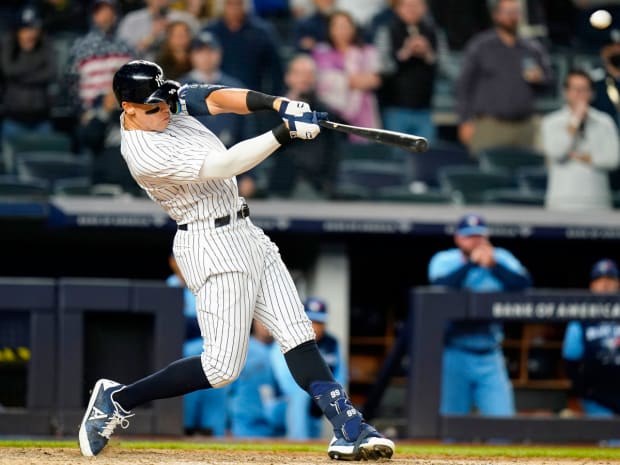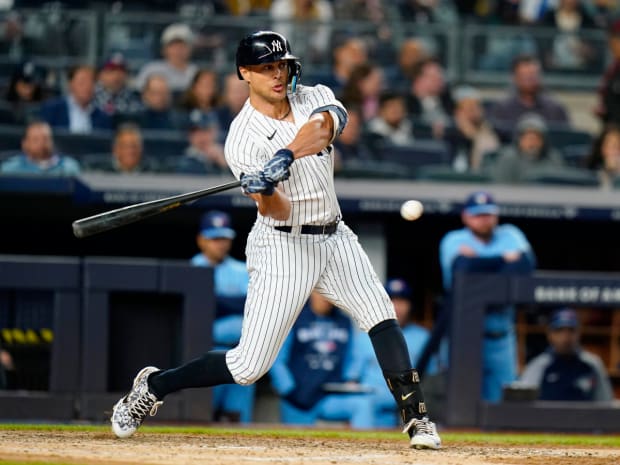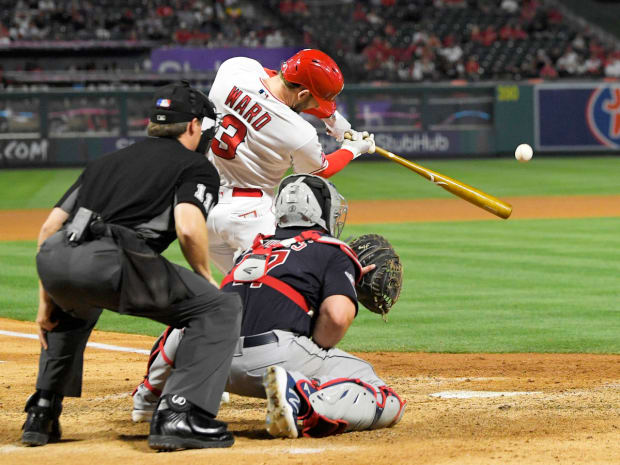Welcome to The Opener, where every weekday morning during the regular season you’ll get a fresh, topical column to start your day from one of SI.com’s MLB writers.
By the end of this week—as they start a 10-game stretch with seven games against Baltimore—the Yankees will have played a quarter of their schedule. O.K., we’re not yet to Memorial Day and the great Sparky Anderson always considered 60 games a benchmark for where a team is headed. But with the way this team looks, it’s not too early to declare this team the best in baseball this year—with a chance to join the company of historic teams.
Here are the undisputed facts:
• The Yankees are 25–9 for the ninth time in their history. They won the pennant each of the previous eight times they started this well (with six World Series titles).
• They have allowed only 98 runs in 34 games. Only one other Yankees team was better at run prevention after 34 games, the 1958 team (95).
• They are 20–1 when they score more than three runs.
• You must go back to the Dead Ball years of 1904 and ’10 to find a Yankees pitching staff with a lower WHIP.

AP Photo/Frank Franklin II
Any discussion of the 2022 Yankees must begin with Aaron Judge, who before Opening Day turned down $31.5 million a year for seven years, which is not crazy when Anthony Rendon, Giancarlo Stanton and Gerrit Cole will be pulling down more coin. Judge is better than ever. He is destroying fastballs, pulling home runs when the count works in his favor and playing a stout center field at a height never before seen. (Walt Bond played 11 career games there at 6'7". Judge has played 33 games there, including 11 of the first 34 this season, allowing manager Aaron Boone important lineup flexibility.)
“I mean, he was great when he got here,” Boone says. “I think he’s just more—the experience and every factor of how to prepare. He’s smart, he knows the league better, knows what to look for more, knows how to take care of himself more, knows how to prepare physically. He has become more of a leader, too.”
Everything that could go right has gone right. The team has been extraordinarily healthy. Gleyber Torres, with the help of hitting coaches Dillon Lawson and Hensley Meulens, junked his incessant bat waggle, which led to timing issues and his front hip leaving too early last year. Now he sets the bat on his shoulder and doesn’t move it until the pitcher moves. The result? The same guy who slugged just .352 against fastballs last year is slugging .538 against them. He is on time and on balance.
DJ LeMahieu is hitting the ball hard again after sports hernia surgery. Josh Donaldson, who last year had a better exit velocity than in his MVP season, is giving the team an edge as Boone protects him from the wear and tear of playing third base too much. Stanton is hitting the ball harder (97.4-mph average exit velocity) and finding the barrel more frequently (16.3% of his plate appearances) than in full any season since at least 2015. The team has cut down on its strikeouts.
That the Yankees can hit is no surprise, not with two MVPs and 10 All-Stars. The only possible knock is they field the oldest group of hitters in baseball (30.7 on average), though Boone’s “load management” policy seems to have that in order.
The bigger surprise is how well the Yankees have pitched. They have borrowed from the Giants’ blueprint: They have embraced power sinkers as hitters adjust to high fastballs, they throw strikes, they control counts and they defend the home run. The Yankees are fourth in strike percentage and second in fewest home runs allowed; the Giants lead in both categories.

AP Photo/Frank Franklin II
Nestor Cortes Jr., Luis Severino, Clay Holmes, the depth of the bullpen … all of it is real. And the pitching plays up because of their enhanced defense and the exquisite work behind the plate by Kyle Higashioka and Jose Trevino. The trade with Minnesota that netted Donaldson was worth it to move on from the constant maintenance of Gary Sánchez behind the plate.
Don’t go putting these Yankees in the same category yet as the 1998 Yankees, one of the greatest teams of all time. Too much season remains to go there. But as we approach the quarter pole of the season, the Yankees, without an obvious flaw, are the class of baseball so far this year.
Defense is back in vogue.
Batting average on balls in play is .284, down eight points from last year, down 16 points from just five years ago and the lowest level in 32 years.
“Defense is on another level,” Boston manager Alex Cora says. “You see Toronto and they shift everybody. [George] Springer down the line, four-man outfield and you hit a rocket and they’re right there. You have to really earn your hits. People talk about Baltimore like they’re nothing, but they’ve got some great stuff.”
It’s not just about the less lively baseball. Players now know they are paid based on WAR, and they are looking for ways to boost their WAR. Some outfielders, for instance, have learned to take a first step as the ball crosses the plate—to improve their “reaction” metrics. Most play deeper to get more range.
As with video games, teams are using defensive “points” as a reward system. For instance, every morning the Red Sox distribute an internal email to players with the “results” from defensive plays the previous night. Shortstop Xander Bogaerts and third baseman Rafael Devers have bought into the system.
“Devers and Xander did drills on their first steps in the offseason,” Cora says. “[Devers] is moving well. All of these players want to know how the whole system works. We had a meeting about all the plays, what it means and all that. We send an email every day with all the plays from the night before. Exit velocity and expected catch, all the cool stuff. But they wanted the point system. The ‘plus 0.2’—what they saved and what they didn’t save. Now it’s a real game for them. Xander makes those plays and he’s like, “Let’s see how many points I got today.’”
The results have been mixed for Bogaerts and Devers. Bogaerts was at a -3 defensive runs saved. But Devers has improved from last among third basemen last year at -13 (tied with Alex Bohm) to a respectable 0, which puts him in the middle of the pack.
Old school, defense-first shortstops are making a bit of a comeback. Among the top five shortstops in DRS are Nico Hoerner of the Cubs, Jorge Mateo of the Orioles and Andrew Velazquez of the Angels. Rookie Jeremy Peña of the Astros has been a standout on both sides of the ball.
One of the great stories of this season—especially with offense so down—is the breakout of Angels outfielder Taylor Ward. Until this season, Ward, 28, slashed .230/.305/.388 over parts of four seasons. But with the help of a book on the mental side of athletics and a personal hitting coach who sells medical devices in Texas, Ward is posting a whopping AL-best slash line of .385/.500/.747.

AP Photo/Mark J. Terrill
A former first-round pick out of Fresno State, Ward was teammates with Judge for one season there and was drafted as a defense-first catcher. One prospect publication wrote that Ward “lacks a natural feel for hitting.” But Ward’s makeup was off the charts.
When the Angels called his coach at Shadow Hills High in Indio, Calif., Teg Diffey, before the draft, the coach compared him to a dog that loves retrieving a ball even to exhaustion. “You’re never going to have any trouble with him, and he’s going to represent the organization well,” the coach said.
Over the years the Angels moved Ward from catcher to third base to the outfield. His biggest problem was a loop in his swing Angels coaches unsuccessfully tried to eliminate.
One day in 2020, assistant hitting coach John Mallee gave Ward a book called Mind Gym: An Athlete’s Guide to Inner Excellence. That same year, Ward fine-tuned his swing both at the Long Beach training site while the season was suspended due to COVID-19 and with his personal hitting coach, Trent Woodward. The two of them have been working together for four years. Woodward played with Ward at Fresno State and played four years of minor league baseball in the Houston system before he joined the sales business out of Austin.
“He’s great,” Ward says. “He’s just such a great guy who will help anybody—for free. The biggest thing he did for me was to take out all the excess movement. Anything extra in the setup or load we worked to eliminate.”
The result is one of the simplest swings in baseball. Ward holds the bat parallel to the ground so that his hands need only to move straight to the baseball. It’s almost as if he presets the angle at which the barrel will enter the zone. But once the bat enters the zone, Ward has elite extension through the baseball, which generates his power. The most similar swings belong to Mitch Haniger of the Mariners and Rhys Hoskins of the Phillies.
“Those are both great,” Ward says. “I love studying swings. If there’s one guy who really stands out to me it’s Trevor Story.”
The result of the changes is a highly confident hitter who has simplified the sport. Thanks to his devotion to the mental side of the game, Ward hits with such calmness that he decided to auto-take on a full count pitch with the bases loaded and down by a run to Baltimore. Sure enough, the pitch was a ball. He doesn’t hunt or sit on pitches but reacts to the baseball—and trusts his instincts.







